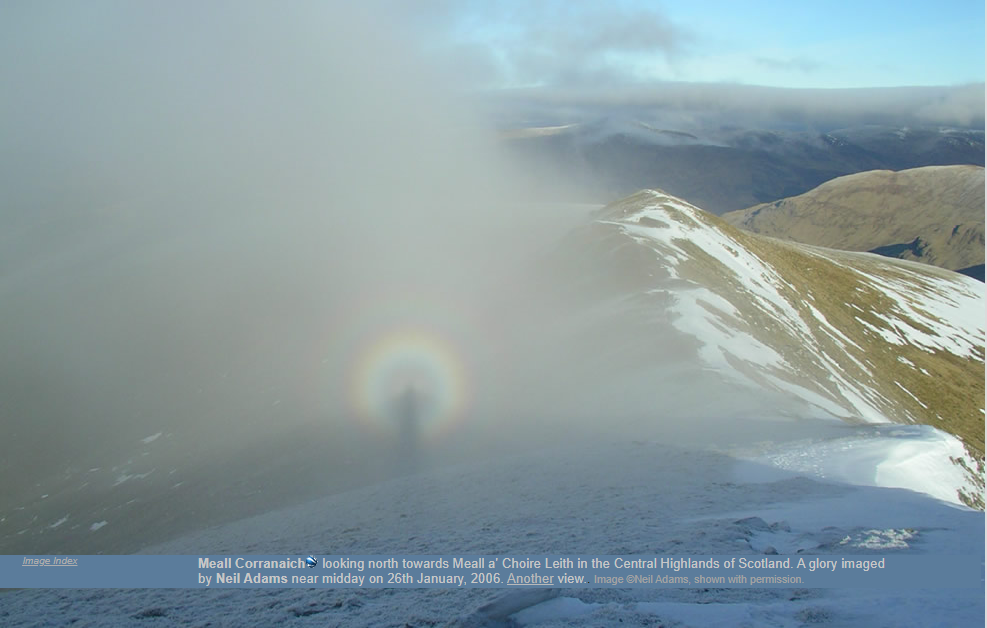Glory - Meall Corranaich, Scotland
Glory - Meall Corranaich, Scotland: A Spectacular Atmospheric Phenomenon
Have you ever witnessed a mesmerizing optical phenomenon in the sky? If not, let me introduce you to the captivating glory, a breathtaking display of light that can be observed under the right atmospheric conditions. One such instance occurred on January 26th, 2006, near midday, over Meall Corranaich in the Central Highlands of Scotland. Neil Adams was fortunate enough to capture this awe-inspiring moment, and we are privileged to witness it through his photograph.
A glory is an optical phenomenon that manifests as a series of concentric rings of colored light surrounding the shadow of an observer cast on a cloud or mist. It appears as a circular band of colors, with red on the outer edge and blue on the inner edge, encompassing a shadowy center. The phenomenon is caused by the diffraction and interference of sunlight by water droplets or small ice crystals in the atmosphere.
The glory captured over Meall Corranaich is a stunning example of this atmospheric spectacle. As sunlight passes through the cloud or mist, it interacts with the tiny water droplets suspended in the air. The droplets act as miniature prisms, bending and scattering the light in different directions. This scattering gives rise to the distinct rings of colors that form the glory.
The size and intensity of a glory depend on various factors, including the size and shape of the water droplets or ice crystals, the angle at which sunlight enters the droplets, and the observer's position relative to the phenomenon. The glory over Meall Corranaich appears particularly vibrant and well-defined, suggesting optimal conditions for its formation.
It is interesting to note that a glory is always centered on the antisolar point, which is directly opposite the position of the sun in the sky. In this case, the glory was observed while looking north towards Meall a' Choire Leith, and the shadow of the observer played a crucial role in its formation. The shadow acts as the focal point for the rings of light, creating a mesmerizing display that seems to encircle the observer.
Glories are often seen in conjunction with other atmospheric optical phenomena, such as fogbows or Brocken spectres. These captivating displays can occur in various locations around the world, but their appearance is dependent on specific atmospheric conditions. The occurrence of a glory is a testament to the intricate interplay between light and water droplets in our atmosphere.
In conclusion, the glory captured over Meall Corranaich in Scotland is a remarkable example of an atmospheric optical phenomenon. Its vibrant rings of colored light surrounding the observer's shadow create a mesmerizing display that leaves spectators in awe. Understanding the science behind this phenomenon enhances our appreciation for the intricate beauty of our natural world. Next time you find yourself gazing at the sky, keep an eye out for the elusive glory and let its ethereal beauty captivate your senses.

Meall Corranaich looking north towards Meall a' Choire Leith in the Central Highlands of Scotland. A glory imaged by Neil Adams near midday on 26th January, 2006. Another view.. Image ©Neil Adams, shown with permission
Note: this article has been automatically converted from the old site and may not appear as intended. You can find the original article here.
Reference Atmospheric Optics
If you use any of the definitions, information, or data presented on Atmospheric Optics, please copy the link or reference below to properly credit us as the reference source. Thank you!
-
<a href="https://atoptics.co.uk/blog/glory-meall-corranaich-scotland/">Glory - Meall Corranaich, Scotland</a>
-
"Glory - Meall Corranaich, Scotland". Atmospheric Optics. Accessed on November 26, 2024. https://atoptics.co.uk/blog/glory-meall-corranaich-scotland/.
-
"Glory - Meall Corranaich, Scotland". Atmospheric Optics, https://atoptics.co.uk/blog/glory-meall-corranaich-scotland/. Accessed 26 November, 2024
-
Glory - Meall Corranaich, Scotland. Atmospheric Optics. Retrieved from https://atoptics.co.uk/blog/glory-meall-corranaich-scotland/.